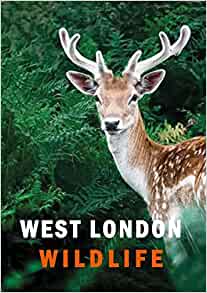BOOK REVIEW: West London Wildlife by Ian Alexander et al. (2022) Supernova Books/Aurora Metro. £19.99.
 This slim volume of 136 pages with hard covers and numerous colour photos immediately exudes quality: it feels like a book we would want to read, especially as it covers a part of London, a place just an hour away for us by train that we try and visit regularly in search of its hidden gems, of wildlife as much as anything else.
This slim volume of 136 pages with hard covers and numerous colour photos immediately exudes quality: it feels like a book we would want to read, especially as it covers a part of London, a place just an hour away for us by train that we try and visit regularly in search of its hidden gems, of wildlife as much as anything else.
It consists of a series of 14 essays covering different sites or areas of West London, written by ten different authors, interspersed with many colour photos (including double-page spreads). The diverse writing styles of the different authors add to the charm of the book, each seemingly representing an authentic voice of experience and expertise.
In addition, between each chapter, there is a full-page image opposite a short ‘inspirational quote’, generally well-chosen and apposite; while some may see these as ’padders’, we found them useful to give the book space to breathe, the rest of the pages being either full of words and photos, or completely given over to large images. To our mind, these large images are just too big on the page, though this is a purely personal preference. But worse still, for the double-page spreads, the images have sometimes been badly let down by the design, with the main focus of the photo deeply riven by the central gutter.
One thing we would have liked to have seen is an Introduction giving the rationale for the book, indeed for the whole series. This could also usefully have included a brief biography of the authors to establish their relationship with their location(s), whether professional or voluntary, although in some cases this can be gleaned from the text; and importantly for anyone not familiar with the metropolis, it should have a basic location map.
There are quite a number of typos, grammatical errors and missing words which should have been ironed out at the editorial stage, together with a worryingly inconsistent approach to some stylistic conventions. In particular, there is inconsistency between chapters (and even within chapters) over the use of initial capitals for species names. For what it is worth, we always prefer those names to have initial caps, but what is crucial for any professional publication is strict consistency. A number of more technical terms (eg ‘saproxylic’, ‘kick-sampling’) are used – for a lay audience, these should either be explained within the text or by means of a glossary. Page 2, the publication details, assertion of rights and photo acknowledgements in completely undifferentiated typescript is simply ugly and a very poor lead in to the rest of the book.
For a book with ‘wildlife’ in its title, factual accuracy is crucial. There are several errors of fact we noticed in the text, and also (unforgivably) several images are labelled wholly incorrectly (for example, a Common Darter is labelled ‘Brown Hawker’, and a Long-winged Conehead is masquerading as ‘Meadow Grasshopper’, an insect in a wholly different sub-order). Given that factual errors are likely to deter some naturalists, an informed technical edit should have sorted those issues out. And also with reference to the title, surely ’West London Wildlife & Wild Places’ would have been better given that the overriding theme of the book is its sense of place?
So who should have this book? Certainly anyone involved in any of the sites will want it on their shelves. Then there are those who might well be inspired to search out these areas, as indeed we have been, such that we have booked a couple of nights away by the Thames at Chiswick in order better to explore, although it is not something we would take with us as a guide-book – if nothing else, its format is too big for a pocket. And everyone with an interest in the natural world has their own pet places to wander and enjoy its benefits. All too often such places are suffering at the hands of Man, and so need the sorts of actions, understanding and care that are amply demonstrated here. Each individual story could provide such inspiration for somebody faced with similar challenges, wherever they are.
Review by Chris & Jude Gibson